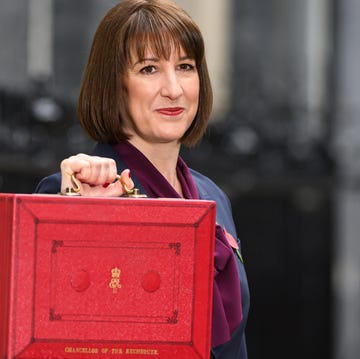It's one of those questions that we ask ourselves with increasing regularity as we get older — will I have enough money to live on in retirement? And how much is enough? Well, new research from the Happiness Research Institute (never have we needed one of these more!) provides a straight answer to these questions.
The happiest retirees have an average monthly income of £1,700. According to the study, written in partnership with Legal & General, this equates to a pension pot of roughly £221,858 at retirement, providing an income of approximately £20,400 a year1 (which includes a full State Pension).
But only a third of UK retirees have this level of income or above. In fact, one in five retirees (22%) live on less than £1,000 a month, falling below the Pensions & Lifetime Savings Association's minimum standard for covering essential costs in later-life (£1,200 a month, £14,400 annually).
In the next five years alone, according to Phoenix Insights, the majority of defined contribution pension savers (that’s around half of working age people) will enter retirement with less income than they expect or need, and this will worsen to a peak in the early 2040s. No surprise then that there are calls for an increase in the minimum auto-enrolment contribution rates from 8% to 12%, when economic conditions allow.
Ingredients for a happy retirement
But just for a moment, let’s go back to the good news, the L&G study also shows that happiness in retirement isn’t all about money. While higher incomes do coincide with greater happiness among retirees, the boost they bring begins to level off as income surpasses about £2,000 a month, according to the L&G research. Regardless of income, other factors are important too, such as social connections and good health. The happiest retirees were also more likely to be satisfied with their day-to-day routines, free time, relationships with family and friends, and social lives. They were also much less likely to report severe loneliness.
“Being without sufficient resources to make ends meet causes worry and stress and a lower quality of life for people in the UK. That is especially the case for people in retirement. The good news is that there are ways we can improve happiness levels by planning and saving for retirement,” says Meik Wiking, ceo, Happiness Research Institute.
What’s your pension target?
Research from the Pensions and Lifetime Savings Association shows that the annual income people will need for a minimum standard of living in retirement now stands at £14,400 for a single person and £22,400 for a couple. This factors in all your essential needs, with some left over for fun and social occasions, such as a holiday in the UK, eat out once a month and some affordable leisure activities twice a week.
Looking for a moderate standard of living, the bar is set at £31,300 for a single person and £34,000 for a couple. This would provide more financial security and flexibility for fun, such as having one foreign holiday a year and eating out a few times a month.
For a comfortable retirement where you can afford more luxuries and spontaneity, the estimate is £43,100 for one person and £59,000 for a two-person household.
Pension gender gap
It’s a myth that women are less interested in pensions than men— almost as many women as men now have private or workplace pensions. But research from Royal London shows women are typically managing to save less for their retirement throughout their working lives, with a gap of 16% in their 30s rising to 43% by the time they reach age 55.
"At the start of people’s career, there’s not much of a difference in the pension savings between men and women, but the effect of having a family and reducing their hours means the gap widens significantly as time goes by. So, at the point of retirement, women typically only have around £60 saved for every £100 that men have,’ says Clare Moffat, pensions expert at Royal London.
"Millions more women may now be saving thanks to auto enrolment, but we can’t escape the fact that parenthood and caring responsibilities interrupt women’s working lives. It’s an issue that affects their take home pay, career opportunities and ultimately their pensions savings," says Clare.
And on top of that, on average, women live longer and therefore have longer retirements, so rather than less savings, they actually need more money for their retirement than men.
How to check your state and workplace pension pots
If you've no clue how much you have in your pension pots, you are not alone. Only 41% of women have a clear idea of what all their pensions are worth (compared with 61% of men), according to Hargreaves Lansdown.
Checking your pensions is easier than you think:
- Find out how much State Pension you could get and when at gov.uk/check-state-pension.
- To check on your workplace pension, or any personal pension, for your estimated pension income (at your chosen retirement age), use the latest annual statement from your provider(s). "Most pension providers have an online members’ area, so you can check your savings," says Emma-Lou Montgomery, associate director, Fidelity International. "If you haven’t signed up yet, it’s quick and easy to get started; you’ll probably need your reference number and National Insurance number to do so."
- Do a pensions sweep and make sure you include every pension you have paid into. Find out how to trace old pension pots.
- Don’t forget about other savings and investments you could use to boost your income in retirement, too.
How to make sense of your pensions
If you’ve done the above, you probably have a good idea of what your State Pension will be, and when you will get it, and what your workplace and personal pensions are projected to be worth currently. But the mix of lump sums and annual incomes can make it hard to work out how this will equate to an annual income in retirement. The simplest way to find out whether you are saving enough for the kind of annual income you want is by using a pensions calculator tool, such as MoneyHelper’s. Or, make use of the free access to advice through your workplace pension provider.
Typically, for an annual income in retirement of £25,000 (including the state pension) a year, you'd need to have built up a pot of around £260,000, according to an estimate by Hargreaves Lansdown. And for an annual income of £50,000 a year, you'd need a pension pot of around £720,000. (This is based on buying an annuity, which will give you an income for life regardless of how long you live. These figures also include tax free cash at 25% Figures correct October 2024).
Helen Morrissey, senior pensions and retirement analyst at Hargreaves Lansdown, says: "These numbers may look daunting but don’t be put off. If you contribute to a workplace pension you will also get money from your employer and a government top up in the form of tax relief. Pensions are a long-term game, and the key is to make regular contributions as much as possible over the course of your working life."
Ways to boost your pension
To get started, check out the pensionattention.co.uk campaign for simple steps and videos on how to boost your savings and trace lost pension savings.
Increase your workplace pension contributions
Doing this by as little as 1% could give you as much as £37,000 more in retirement, according to Fidelity International. A 31-year-old woman, who has been regularly contributing an additional 1% to her workplace pension since the age of 25, could make up the £25,000 shortfall that would otherwise typically occur if she took a two-year career break at 31 to have a baby, according to its data.
Check for gaps
You will need a full 35 years of National Insurance (NI) contributions to get the maximum amount of state pension you are entitled to. You can typically only backdate your NI contribution history by six years. However, the Government is currently allowing people to pay for gaps on their NI record all the way back to 6 April 2006 – a move to help those affected by new State Pension transitional arrangements. You need to act fast to take advantage of this change though, as the deadline is 5 April 2025. Find out more at gov.uk.
Boost your pension on a career break
The bottom line is a break in your earnings will lead to a gap in your pension contributions, both your workplace pension and a loss of National Insurance contributions. This may reduce your state pension entitlement and therefore significantly reduce the level of your income in retirement. The good news is that there are ways to boost your pension:
- Get your partner to pay in for you if you are on a career break and not making contributions. Paying into both pensions will provide financial security for both of you. “Even if you are not earning and you are under the age of 75, most people can still receive £3,600 per year paid into their pension at a cost of £2,880 due to the tax relief this attracts," says Laura Newman, head of financial planning, NatWest Premier. If your situation is complex, seek specialist advice. Also, other people can pay into a personal pension for you, such as a partner, parent or grandparent.
- National Insurance credits. Time spent raising children up to the age of 12, caring for someone who’s sick or disabled or in full-time training is all taken into account in your NI record. You can build up qualifying years, which will count towards your state pension even when you’re not in paid employment. You are credited automatically if you are a parent registered for Child Benefit for a child under 12. If you’re the stay-at-home parent, make sure it’s you that’s registered for Child Benefit rather than the higher earner, so you can continue to accrue State Pension credits.
Caring for grandchildren?
If you are a grandparent under state retirement age who cares for your grandchildren under 12, you may also qualify for NI credits if the working parent donates their Child Benefit credits to you (if they are working, they won’t need them). To find out more, call the government helpline on 0300 200 3500 or visit gov.uk. You can apply for backdated childcare national insurance (NI) credits all the way back to April 2011.
Pension building for the self-employed
If you are self-employed, work part-time, are a gig worker or have multiple jobs, it’s likely you fall outside of the scope of auto-enrolment, so you’ll need to be proactive in pension planning. Self-employed men are earning an average of 43% more than self-employed women, according to Women in Self-Employment.
"Dedicated flexible self-employed pension plans in recent years have made saving for retirement much easier for this group," says Romi Savova, CEO, PensionBee. "Self-employed workers can usually take advantage of tax incentives to boost their savings, such as tax relief on contributions from the Government."
*MoneyHelper offers a mid-life pension review for the self-employed – book online.
Get wise to the pension scammers
Whatever you are planning to do with your pension pot, the advice is not to rush into decisions and potentially expose yourself to fraudsters eager to help part you from your money.
Last year, there were 559 reports of pension fraud in total and £17,750,635 lost, with an average loss of £46,959 per person, according to Action Fraud.
- Warning signs include offers of free pension reviews, higher returns, help to release cash early and high-pressure sales tactics. Fraudsters are most likely to approach you online or through social media. The best advice is to hang up, delete, ignore!
- Check the Financial Conduct Authority’s register to make sure that anyone offering you advice or other financial services is FCA-authorised.
- Search ‘ScamSmart’ online for the latest FCA advice on how to protect yourself. You can report a scam on its consumer helpline: 0800 111 6768.
- Get expert pension advice. Talk to an FCA-authorised financial adviser who specialises in retirement planning. Find one at MoneyHelper, unbiased.co.uk or vouchedfor.co.uk. You can also access a free hour long session with Pension Wise, if you are over 50, to discuss your options.
1 L&G calculations are based on the following assumptions:
•CPI inflation = 3% • Age-related and gender specific salary premium assumed based on ONS Annual Pay data from the Annual Survey of Hours and Earnings • Salary increase = 3% + salary premium as described above • Base assumption that a member will start saving into a workplace pension at age 22, retiring at age 67, with no break in contributions • Investment return on pension pot, assuming broad 60/40 asset split, (6.7% p.a.) • Qualifying earnings – Currently (£6,240 to £50,270), Future years (increased annually by CPI assumption) • Assume the member takes their tax-free cash on retirement and a full state pension • Figures quoted are post tax • Estimated income based on current open-market annuity rate of 20.4, available at https://www.hl.co.uk/retirement/annuities/best-buy-rates. Single life, RPI indexation with a 5-year guarantee assumed














